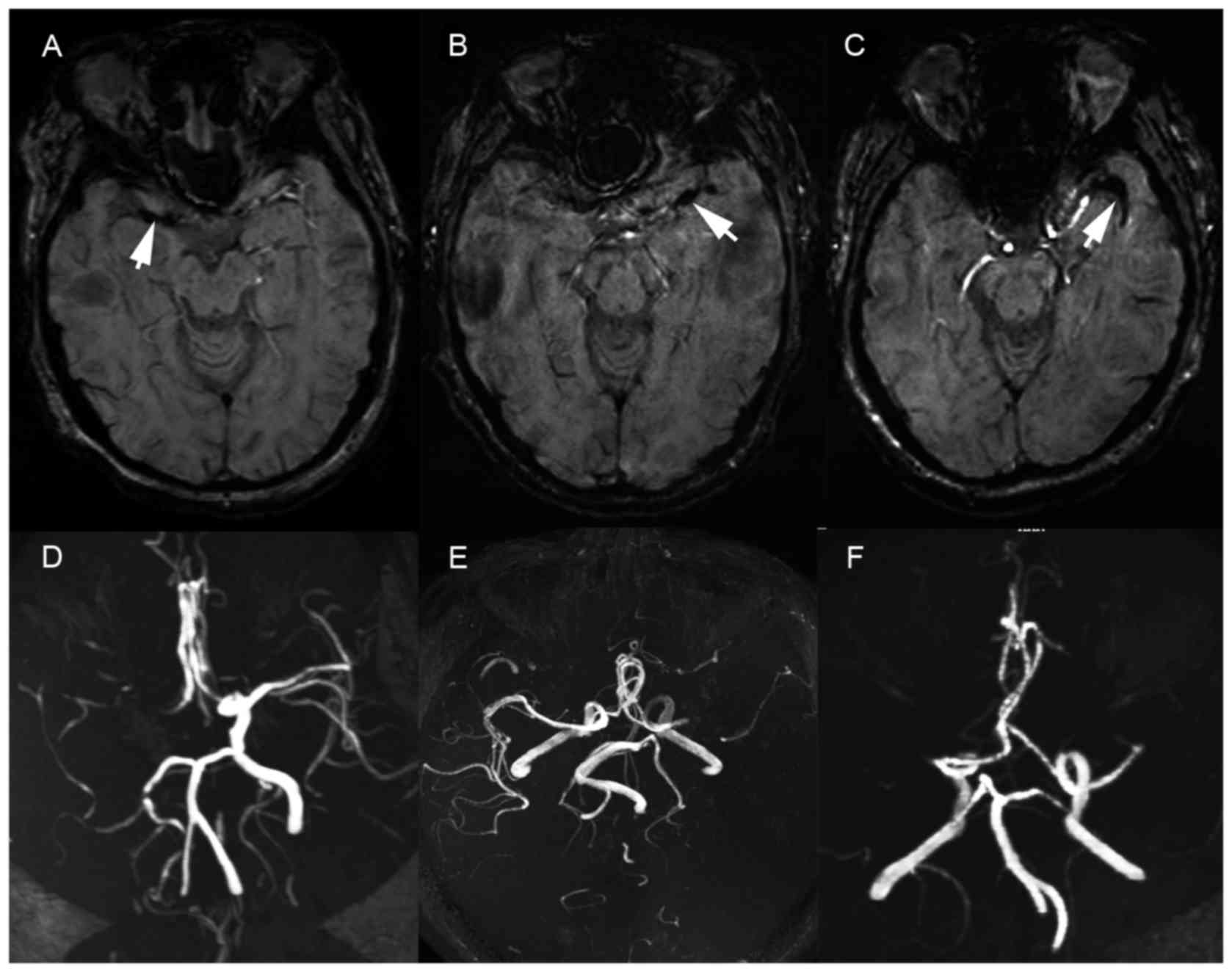|
1
|
Somford DM, Nederkoorn PJ, Rutgers DR,
Kappelle LJ, Mali WP and van der Grond J: Proximal and distal
hyperattenuating middle cerebral artery signs at CT: Different
prognostic implications. Radiology. 223:667–671. 2002. View Article : Google Scholar : PubMed/NCBI
|
|
2
|
Schellinger PD, Chalela JA, Kang DW,
Latour LL and Warach S: Diagnostic and prognostic value of early MR
Imaging vessel signs in hyperacute stroke patients imaged <3 h
and treated with recombinant tissue plasminogen activator. AJNR Am
J Neuroradiol. 26:618–624. 2005.PubMed/NCBI
|
|
3
|
Flacke S, Urbach H, Keller E, Träber F,
Hartmann A, Textor J, Gieseke J, Block W, Folkers PJ and Schild HH:
Middle cerebral artery (MCA) susceptibility sign at
susceptibility-based perfusion MR imaging: Clinical importance and
comparison with hyperdense MCA sign at CT. Radiology. 215:476–482.
2000. View Article : Google Scholar : PubMed/NCBI
|
|
4
|
Cho KH, Kim JS, Kwon SU, Cho AH and Kang
DW: Significance of susceptibility vessel sign on T2*-weighted
gradient echo imaging for identification of stroke subtypes.
Stroke. 36:2379–2383. 2005. View Article : Google Scholar : PubMed/NCBI
|
|
5
|
Park MG, Yoon CH, Baik SK and Park KP:
Susceptibility vessel sign for intra-arterial thrombus in acute
posterior cerebral artery infarction. J Stroke Cerebrovasc Dis.
24:1229–1234. 2015. View Article : Google Scholar : PubMed/NCBI
|
|
6
|
Kimura K, Iguchi Y, Shibazaki K, Watanabe
M, Iwanaga T and Aoki J: M1 susceptibility vessel sign on T2* as a
strong predictor for no early recanalization after IV-t-PA in acute
ischemic stroke. Stroke. 40:3130–3132. 2009. View Article : Google Scholar : PubMed/NCBI
|
|
7
|
Aoki J, Kimura K, Shibazaki K, Saji N,
Uemura J, Sakamoto Y and Nagai K: The susceptibility vessel sign at
the proximal M1: A strong predictor for poor outcome after
intravenous thrombolysis. J Neurol Sci. 348:195–200. 2015.
View Article : Google Scholar : PubMed/NCBI
|
|
8
|
Aoki J, Kimura K, Shibazaki K, Sakamoto Y,
Saji N and Uemura J: Location of the susceptibility vessel sign on
T2*-weighted MRI and early recanalization within 1 hour after
tissue plasminogen activator administration. Cerebrovasc Dis Extra.
3:111–120. 2013. View Article : Google Scholar : PubMed/NCBI
|
|
9
|
Aoki J, Kimura K, Shibazaki K, Saji N,
Uemura J, Sakamoto Y and Nagai K: The susceptibility vessel sign at
the proximal M1: A strong predictor for poor outcome after
intravenous thrombolysis. J Neurol Sci. 348:195–200. 2015.
View Article : Google Scholar : PubMed/NCBI
|
|
10
|
Legrand L, Naggara O, Turc G, Mellerio C,
Roca P, Calvet D, Labeyrie MA, Baron JC, Mas JL, Meder JF, et al:
Clot burden score on admission T2*-MRI predicts recanalization in
acute stroke. Stroke. 44:1878–1884. 2013. View Article : Google Scholar : PubMed/NCBI
|
|
11
|
Yan S, Hu H, Shi Z, Zhang X, Zhang S,
Liebeskind DS and Lou M: Morphology of susceptibility vessel sign
predicts middle cerebral artery recanalization after intravenous
thrombolysis. Stroke. 45:2795–2797. 2014. View Article : Google Scholar : PubMed/NCBI
|
|
12
|
Soize S, Batista AL, Regent C Rodriguez,
Trystram D, Tisserand M, Turc G, Serre I, Ben Hassen W, Zuber M,
Calvet D, et al: Susceptibility vessel sign on T2* magnetic
resonance imaging and recanalization results of mechanical
thrombectomy with stent retrievers: A multicentre cohort study. Eur
J Neurol. 22:967–972. 2015. View Article : Google Scholar : PubMed/NCBI
|
|
13
|
Yan S, Hu H, Shi Z, Zhang X, Zhang S,
Liebeskind DS and Lou M: Morphology of susceptibility vessel sign
predicts middle cerebral artery recanalization after intravenous
thrombolysis. Stroke. 45:2795–2797. 2014. View Article : Google Scholar : PubMed/NCBI
|
|
14
|
Adams HP Jr, Bendixen BH, Kappelle LJ,
Biller J, Love BB, Gordon DL and Marsh EE III: Classification of
subtype of acute ischemic stroke. Definitions for use in a
multicenter clinical trial. TOAST. Trial of Org 10172 in acute
stroke treatment. Stroke. 24:35–41. 1993. View Article : Google Scholar : PubMed/NCBI
|
|
15
|
Naggara O, Raymond J, Ayllon M Domingo,
Al-Shareef F, Touzé E, Chenoufi M, Gerber S, Mellerio C, Zuber M,
Meder JF, et al: T2* ‘susceptibility vessel sign’ demonstrates clot
location and length in acute ischemic stroke. PLoS One.
8:e767272013. View Article : Google Scholar : PubMed/NCBI
|
|
16
|
Higashida RT, Furlan AJ, Roberts H,
Tomsick T, Connors B, Barr J, Dillon W, Warach S, Broderick J,
Tilley B, et al: Trial design and reporting standards for
intra-arterial cerebral thrombolysis for acute ischemic. stroke.
34:e109–e137. 2003. View Article : Google Scholar : PubMed/NCBI
|
|
17
|
Apoil M, Turc G, Tisserand M, Calvet D,
Naggara O, Domigo V, Baron JC, Oppenheim C and Touzé E: Clinical
and magnetic resonance imaging predictors of very early
neurological response to intravenous thrombolysis in patients with
middle cerebral artery occlusion. J Am Heart Assoc. 2:e0005112013.
View Article : Google Scholar : PubMed/NCBI
|















